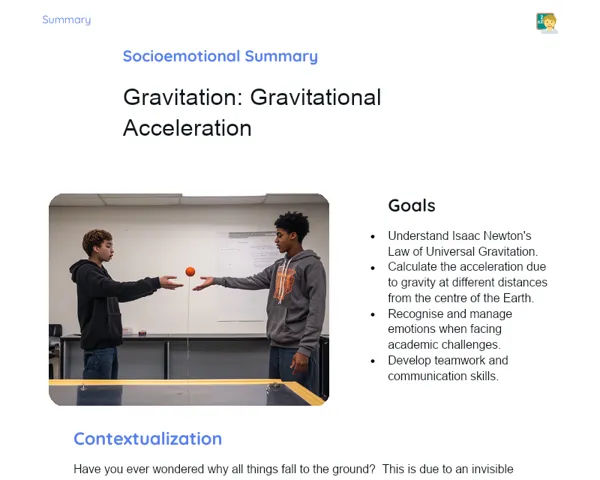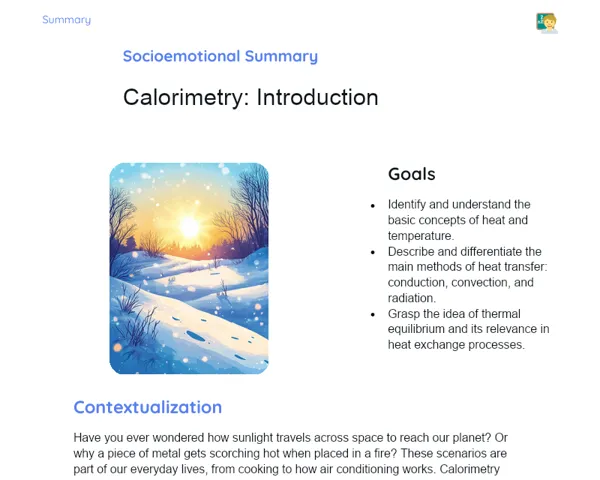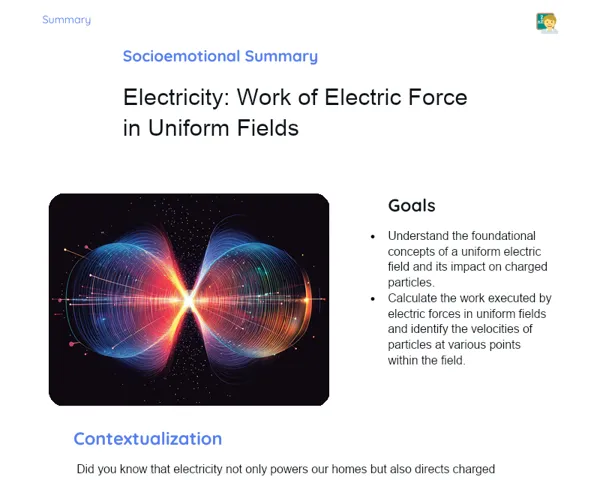Objectives
1. 🔍 Master the Ideal Gas Law to calculate pressure, volume, temperature, and moles of gas in various scenarios.
2. 🌍 Use the knowledge gained to tackle real-world and theoretical problems involving gas systems, applicable in both industrial and scientific contexts.
3. 🤝 Develop teamwork, communication, and critical thinking skills while collaborating on problem-solving activities.
Contextualization
Did you know the discovery of the general gas equation was a pivotal moment in the fields of physics and chemistry? Back in the 17th century, scientists like Boyle and Charles carried out experiments that culminated in this essential equation, shedding light on how gases behave under varying conditions of pressure, volume, and temperature. This equation is not only fundamental for grasping natural phenomena but is also vital in modern technologies, such as combustion engines and refrigeration systems, illustrating the importance and breadth of gas studies in physics and engineering.
Important Topics
Ideal Gas Law (Clapeyron's Equation)
Clapeyron's equation, more commonly known as the general gas equation, connects the pressure, volume, temperature, and the moles of an ideal gas. This is a key tool in thermodynamics, allowing us to predict how an ideal gas will act under various conditions. The equation is expressed as PV = nRT, where P stands for pressure, V for volume, n for moles, R is the gas constant, and T is the temperature measured in Kelvin.
-
The equation PV = nRT is based on the assumption that the gas behaves ideally—meaning there are no intermolecular interactions and the volume of the molecules themselves is insignificant compared to the space they occupy.
-
R, the gas constant, changes depending on the chosen units of pressure, volume, and temperature. It's crucial to select the correct unit for R to avoid calculation errors.
-
This equation can be rearranged to derive other useful relationships, such as Boyle's Law (P1V1 = P2V2), Charles's Law (V1/T1 = V2/T2), and Avogadro's Law (V1/n1 = V2/n2).
Standard Conditions for Gases
Standard conditions for gases are set at a pressure of 1 atm and a temperature of 0°C (273.15 K). These conditions serve as a benchmark for measurements and calculations, making it easier to draw comparisons between different gases. The gas constant (R) can be specifically defined under these standard conditions (R = 0.0821 atm·L/mol·K).
-
Standard conditions are crucial for determining the standard enthalpy of formation and for carrying out thermodynamic calculations.
-
Altering standard conditions impacts gas behaviour, and this should be taken into consideration during experiments or simulations.
-
The selection of standard pressure and temperature has direct implications on the accuracy and relevance of experiments and thermodynamic calculations.
Ideal Gas vs. Real Gas
While the general gas equation is incredibly useful, it primarily describes the properties of an ideal gas—a theoretical model. In reality, real gas molecules take up space and interact with one another, which can result in significant deviations from the predictions made by Clapeyron's equation. These discrepancies are often addressed by incorporating correction factors such as the compressibility factor.
-
Real gases particularly deviate from the predicted ideal gas behaviour at high pressures and low temperatures, where molecular interactions are more pronounced.
-
Understanding the behaviour of real gases is essential in various fields, including process engineering, where reactor and compressor designs depend on precise gas behaviour assessments.
-
More sophisticated theoretical models, such as Van der Waals' equation, are employed to provide a more accurate depiction of real gas behaviour under diverse conditions.
Key Terms
-
Clapeyron's Equation: The general gas law linking pressure, volume, temperature, and the moles of an ideal gas.
-
Standard Conditions: Reference conditions of 1 atm pressure and a temperature of 0°C (273.15 K), used to compare different gases' behaviour.
-
Ideal Gas: A theoretical gas model that has no molecular volume and does not engage in interactions with other molecules, behaving according to Clapeyron’s equation.
For Reflection
-
How does the selection of standard conditions influence the interpretation of results in gas-related experiments?
-
Why is it vital to understand how real gases behave, even though Clapeyron's equation is frequently employed for simpler calculations?
-
In what ways does our understanding of gas behaviour impact the development of technologies such as engines and refrigeration systems?
Important Conclusions
-
We delved into the Ideal Gas Law, a fundamental thermodynamic tool that outlines the behaviour of ideal gases under various conditions of pressure, volume, temperature, and moles.
-
We discussed the significance of standard conditions for gases (1 atm, 0°C) in standardising measurements and calculations, which facilitates comparisons across different gases.
-
We acknowledged that Clapeyron's equation models ideal gases and that in reality, real gases can demonstrate considerable deviations, especially at high pressures and low temperatures.
-
We explored the practical implications of these concepts across a range of applications, from refrigeration systems to space engineering, underscoring the importance of gas studies in contemporary science and technology.
To Exercise Knowledge
- Calculate the volume of gas required to inflate a party balloon with a diameter of 40 cm to a pressure of 2 atm at room temperature (25°C). 2. Determine the final pressure of a gas that starts at 2 atm and 300 K if its volume is reduced to one-third of its original size. 3. Create a report comparing the predicted behaviours of ideal and real gases in an adiabatic compression experiment, discussing the factors that lead to any discrepancies in the results.
Challenge
Submerged Balloon Challenge: Imagine a helium balloon inside a sealed container that can be submerged under water. Calculate how the balloon's volume changes when it's immersed in hot water versus cold water. Explain these changes based on Clapeyron's equation and the behaviour of real gases.
Study Tips
-
Practice applying the general gas equation using various units of measurement for pressure, volume, and temperature to get comfortable with selecting the correct units and understanding the constant R.
-
Explore online simulations or virtual experiments that showcase gas behaviour under different conditions for a better understanding of the ideal vs. real gas concepts.
-
Employ mind maps or visual summaries to organise the relationships between pressure, volume, temperature, and gas quantity to aid in memorisation and comprehension of the material.



